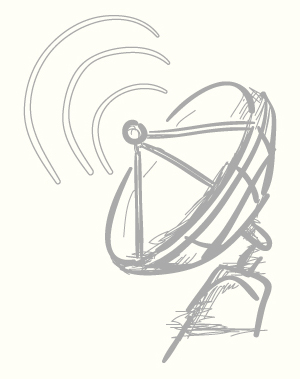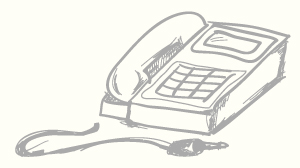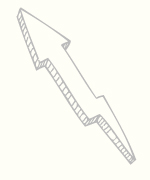
This article will address why you should turn off your laptop, put away your tablet, and go back to the basics during your design process, as well as provide some of the best tips to getting started with effective sketching.
The benefits of sketching in the design process
1. It lets you dig deeper
When you first start a project, there’s a tendency to automatically start coming up with different ideas. These ideas may seem great at first, but the truth is, there’s a big chance that your first ideas are pretty obvious.
For example, if you were creating a logo for an orange juice company, the first, obvious solution most people would think of would be an orange. While the logo will probably end up having something to do with an orange, what can you do to present this orange in a new and unusual way?
Use sketching to find out.
Sketching lets you get all the obvious ideas out of the way, so you can start coming up with stronger, more innovative concepts. Plus, you never know what will inspire you – it could be one of those obvious sketches that spark a million dollar idea!
2. You can do it from anywhere
These days you can take a laptop almost anywhere, but taking a sketchbook and a pen is even more convenient. With a sketchbook you might end up finding yourself in more rural areas like rivers and parks, as well as museums and subways, and who knows where else! Another benefit is that you will be exposing yourself to different environments, which will inspire your designs and bring you new ideas.

There’s something about holding a pencil in your hand that gets your creative juices flowing in a much different way than holding a mouse. When you get used to sketching, the movements of your hand become much more fluid and it becomes really easy and natural. You may also start seeing some ‘artistic’ influences in your design work.
The more you practice, the better you will become at sketching.
4. Expand your abilities and develop a skill
As a designer, it pays off to have a varied skill-set. Developing a strong ability to sketch will allow you to present ideas quickly and easily on paper – for yourself, your art director, or for your clients.
5. Know why you’re designing
One of the most important benefits of sketching is that it gets you in touch with your design work on a whole new level. By spending so much time developing a solid concept, you have a stronger understanding of the elements that go into your design, and you’re able to explain it more eloquently to clients and defend it more successfully if disagreements arise.
Tips for getting started

These can come in very handy when you’re starting a new project, or completely stuck with one you’ve been working on for a while. With both minds maps and word lists you basically list every possible word that’s related to the subject of your project. When I use these for my projects, I first come up with all the words I can think of, then circle the best ones and create little sketches for them to get things going.
I’ve heard there are several online applications for these brainstorming methods, but nothing beats doing it on paper, where there’s full freedom to go with the flow of your associations, and add sketches too. Plus, if you’re hesitant about actual sketching, this is a great way to ease into it.
Draw something, draw anything
Often, especially when you haven’t sketched in a while, facing a blank page can be a bit intimidating. Sometimes it’s hard to know where to start and what you’re supposed to sketch.
Just sketch anything!
Start with a dot, a line, a circle, a square. It doesn’t matter. Just let your mind wander and your hand wander with it. Fill a whole page with doodles if you have to. It’s much less intimidating to face a page that has some character than a blank one. As long as you’re sketching something, you’re on the right track to coming up with your next great idea!
Mistakes are opportunities in disguise
Keep this in mind: your sketches don’t have to be the next Mona Lisa. Sometimes when I sketch, I find myself wanting to make things “perfect”. Don’t fall into this trap…every ‘mistake’ you make is really an opportunity to get better and learn. Welcome these ‘mistakes’ – take them on as challenges and you’ll grow as a designer.
In fact, experiment with making some of your sketches as ugly as possible – make them practically hideous! If you plan on drawing a circle, draw a jagged, oddly shaped ellipse. This will help you loosen up and express the ideas that come to you freely, without getting caught up in how well you can draw.
If all else fails, remember this: no one has to see your sketches – you can keep them as private as you’d like – so don’t be shy!
Sketch the worse possible solution
A while back I was working on some cover designs for a product for firefighters. I had a pretty massive creative block at the time – the kind that sinks its teeth into your brain and gets you irritated at every moving (and non-moving) thing around you. For the life of me I could not come up with the ‘perfect’ idea… I couldn’t sketch… Nothing.
I was talking about this to a friend of mine, and he asked me the following question: “What’s the worst possible design you can come up with for this?”
Now there was a question I could answer easy as pie. I could have a giant fire truck with two muscular firemen in suspenders (who are obviously not firemen) holding their axes, with giant flames in the background…oh, and don’t forget the water hose. I sketched this, got a good laugh, and before I knew it my creative block dissolved like two Alka-Seltzer in water.
Here’s my point: when you come up with the worst possible solutions for a design, and give them life by sketching them, it frees your mind from their weight, and leaves it open to new, innovative, and brilliant ideas.
Sketch everywhere
I like to buy notebooks and sketchbooks, it’s a bit of an obsession I have, since I just can’t resist them, no matter how hard I try. I also like to designate specific notebooks and sketchbooks for specific things. “This will be the sketchbook for my own branding,” I say. “And that one will be for making to-do lists! And that other one will be great for client projects.”
Unfortunately (well, maybe it’s not unfortunate), it doesn’t always end up like that. The sketchbook I designated for my own branding ended up serving as all of the above.
Which brings me to my next point: sketch anywhere and everywhere. Ideas have the tendency of visiting us at unpredictable times, and in unpredictable places. It’s often hard to keep track of which idea is supposed to go in which notebook, and which one you’re supposed to be carrying around. My solution to that is to use whatever’s available – even napkins.
Sketch everything
Including sketching as a significant chunk of your design process requires a bit of falling in love with it. It makes the process much more enjoyable and lets you to really dive into it without dreading it.
To start falling in love with it try sketching in your free time, too. Sketch things for fun – things that interest you – big things, little things, tall things, short things, trees, buildings, clocks, pens, robots, fluffy animals… whatever floats your boat. Personally, I really, really like sketching fruits and vegetables… interestingly enough it makes me quite happy.
Experiment
Find what works best for you. Try using different tools like pens, pencils, watercolors, charcoal, and chalk – to name a few – as well as different surfaces. Use ones with which you feel you can express yourself in the best possible way and you enjoy most. The more fun you make this for yourself, the easier it will be to stick to it.
What do you think? Add your thoughts
How important is sketching in your design process? Do you mainly rely on technology or paper to develop your ideas? Plus, do you have any other tips to share that worked well for you?
Keep the conversation going...
Over 10,000 of us are having daily conversations over in our free Facebook group and we'd love to see you there. Join us!

